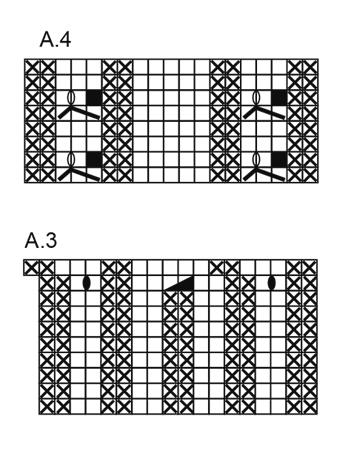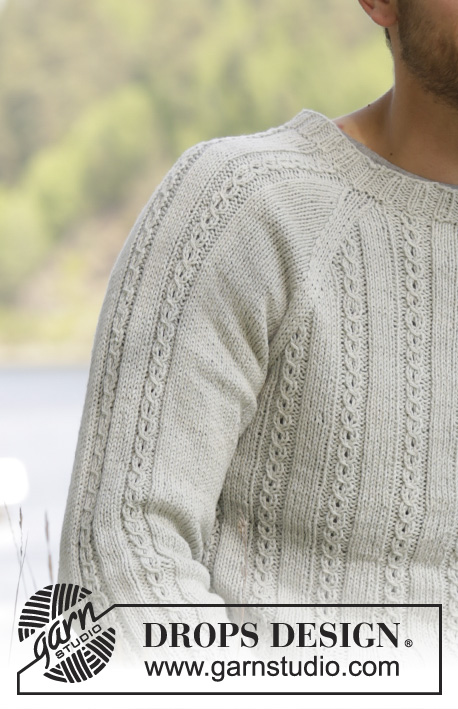Comments / Questions (41)
![]() Ann-Christin Stockfors wrote:
Ann-Christin Stockfors wrote:
Sista varvet på A1 och A3 ska väl inte förskjutas så att rät maska stickas över avig maska? Man får ju extramaskan mellan 2 räka maskor.
28.04.2024 - 10:05DROPS Design answered:
Hej Ann-Christin, ja det stemmer, du får 3 rät, 2 avig, 5 rät 2 avig, så ja avig är fortfarande över avig :)
02.05.2024 - 12:10
![]() Baida wrote:
Baida wrote:
Bonjour, je vous remercie pour votre réponse, est ce que vous avez un autre modèle à me conseiller pour que je puisse m'inspirer de son col? Je précise que je tricote ce modèle avec le cotton merino. Je vous remercie.
20.04.2024 - 10:44DROPS Design answered:
Bonjour Mme Baida, nous n'avons pas de filtres pour les modèles avec ou sans réhausseur, il va vous falloir consulter les différents modèles avec raglan/empiècement arrondi dans la même tension pour trouver un exemple. Merci pour votre compréhension. Bon tricot!
22.04.2024 - 07:50
![]() Baida wrote:
Baida wrote:
Bonjour, je suis en cours de tricoter le raglan et je me pose des questions concernant le col. Si on suit les explications ce sera un col pareil devant et dos alors que sur le patron dessiné, on voit que le devant est plus creusé et c'est ce que je voudrais. Comment faire du coup? Je vous remercie. Cdt
18.04.2024 - 07:36DROPS Design answered:
Bonjour Mme Baida, effectivement, dans ce modèle, l'encolure devant et l'encolure dos sont identiques, si vous voulez une encolure devant un peu plus profonde, vous pouvez tricoter quelques rangs raccourcis dans le dos pour former une réhausse. Bon tricot!
18.04.2024 - 08:21
![]() Louisa wrote:
Louisa wrote:
Drops 174-2 A1 is 12st en komt precies uit met 16 herhalingen voor maat S. Dan begin ik aan A.2, daar is 1 hokje zwart en he. Ik maar 11st, ik kom niet uit. Ik houd steken over aan het einde van die regel met het zwarte hokje. Wat doe ik verkeerd?
05.06.2023 - 14:36DROPS Design answered:
Dag Louisa,
Het zwarte hokje is geen steek. Als je het telpatroon met de schaar uit zou knippen, dan zou je het zwarte hokje er ook uit moeten knippen. Dus de naalden waarin je omslagen maakt in A.2 beginnen met 1 recht, 1 omslag, 1 recht, 2 averecht.
07.06.2023 - 11:31
![]() Trine Valland wrote:
Trine Valland wrote:
Hei, jeg nærmer meg avslutningen av senteniel-genseren og har spørsmål til dette. Målskissen viser at ryggen er lengre enn forran (5 cm), men jeg greier ikke finne at det er beskrevet i teksten. Overser jeg noe? Setter stor pris på avklaring. :-)
26.05.2023 - 23:24DROPS Design answered:
Hej Trine, nej ryggen er samme længde som forstykket. De 5 cm viser stykket mellem der hvor raglanen slutter og øverst på skulderen :)
29.05.2023 - 14:05
![]() Helga Tong wrote:
Helga Tong wrote:
Habe jetzt gesehen, grundsätzlich fehlt die Anleitung für die Abnahmen beim Halsausschnitt, Vorder - und Rückenteil. Bitte um Hilfe
23.01.2023 - 13:50DROPS Design answered:
Liebe Frau Tong, wie vorher beanwortet gibt es hier keine besondere Abkette für den Halsausschnitt, der wird vorne und hinten gleich (Maßskizze war da standard). Viel Spaß beim stricken!
23.01.2023 - 14:59
![]() Helga Tong wrote:
Helga Tong wrote:
Bei dem Modell Sentinel 174-2 fehlt in der Anleitung beim Stricken der Halspasse die Beschreibung für die Abnahme des vorderen Halsaussschnites (Gr. XL). Laut Schnittzeichnung ist dieser auch, wie üblich, im Voderteil 5 cm tiefer als im Rückenteil. Komme jetzt nicht weiter, weil mir die Anleitung dazu fehlt. Bitte um baldige Hilfe.
23.01.2023 - 11:30DROPS Design answered:
Liebe Frau Tong, die 5 cm bei der Schulter in der Maßskizze ist die Höhe für den Schulter, nicht für die Erhöhung, bei diesem Modell gibt es keine Erhöhug, so sind beide Halsausschnitte vorne und hinten gleich. Viel Spaß beim stricken!
23.01.2023 - 14:53
![]() Ria wrote:
Ria wrote:
You say (Repeat dec on every other round 22 more times and then on every round 6 times). What do you mean? Do we make the dec on round 1,2,3,4, etc for 22 rounds or on round 2,4,6, etc?
06.01.2023 - 02:03DROPS Design answered:
Hi Ria, You decrease every other round (rounds 3,5,7,9 etc.) 22 more times after the first decrease on round 1, then every round for 6 rounds after that. Happy knitting!
06.01.2023 - 08:27
![]() Charlotte Wesselhoff wrote:
Charlotte Wesselhoff wrote:
Jag har kommit till mönsterdel A2 När jag har stickat 1:a raden "ta 1 m löst av stickan som skulle stickas rät, sticka 2 rm, dra den lyfta m över. " då har jag minskat 2 m. Andra raden svart ruta ska vara ingen maska. Om jag tänker ingen maska så får jag bara två räta maskor men behöver 3. Hur ska jag sticka för att få tillbaka de 2 m som jag har minskat och därmed få 3 m r?
19.08.2022 - 17:58DROPS Design answered:
Hei Charlotte. Det står: "ta 1 m löst av stickan som den skulle stickas rät, sticka 2 rm, dra den lyfta m över" = 1 felt maske, ikke 2. Du strikker ikke 2 rett sammen, men 2 rett masker. Da vil mønstret/maskeantallet stemme. mvh DROPS Design
22.08.2022 - 11:48
![]() Rosie wrote:
Rosie wrote:
Que significa “aquí no hay punto “ No sé qué hacer ahí
01.07.2022 - 01:05DROPS Design answered:
Hola Rosie, este cuadrado se refiere a la posición de un punto disminuido en la fila/ vuelta anterior. Como la representación del diagrama intenta ser 3d (indicando la posición de los puntos), usamos este símbolo para enseñar que no debería haber ningún punto ahí. A la hora de trabajar, simplemente ignora este símbolo y sigue trabajando con el siguiente símbolo en el diagrama (sin saltar nada).
02.07.2022 - 15:53
Sentinel#sentinelsweater |
||||||||||||||||||||||
 |
 |
|||||||||||||||||||||
Knitted DROPS men’s jumper with cables and raglan in Belle. Size: S - XXXL.
DROPS 174-2 |
||||||||||||||||||||||
|
GARTER ST (in the round on circular needle): * K 1 round and P 1 round *, repeat from *-*. 1 ridge = 2 rounds. PATTERN: See diagrams A.1 to A.4. RAGLAN: Dec 2 sts in every transition between body and sleeves. Dec as follows from RS: Beg 3 sts before marker and work as follows: K 2 tog, K 2 (marker is between these 2 sts), slip 1 st as if to K, K 1, psso. ---------------------------------------------------------- JUMPER: Worked in the round on circular needle. BODY: Cast on 192-216-240-264-288-312 sts on circular needle size 3.5 mm with Belle. K 1 round, on next round work A.1 (= 12 sts) over all sts (16-18-20-22-24-26 repetitions). When A.1 has been worked 1 time vertically, switch to circular needle size 4 mm and continue with A.2 over A.1. REMEMBER THE KNITTING TENSION When piece measures 44-45-46-47-48-49 cm, cast off for armholes in each side as follows: Work the first 87-99-111-123-135-147 sts (= front piece), cast off the next 9 sts (= P 2 + K 5 + P 2), work the next 87-99-111-123-135-147 sts (= back piece), cast off the last 9 sts. Put piece aside and knit the sleeves. SLEEVE: Worked in the round on double pointed needles. Cast on 52-52-56-56-60-60 sts on double pointed needle size 3.5 mm with Belle. Insert 1 marker at the beg of round. K 1 round, then work as follows: Size S + M + XXL + XXXL: K 1, * P 2, K 2 *, repeat from *-* over the next 16-16-20-20 sts, A.3 (= 18 sts), * K 2, P 2 *, repeat from *-* over the next 16-16-20-20 sts, finish with K 1. Size L + XL: P 1, K 2, * P 2, K 2 *, repeat from *-* over the next 16-16 sts, A.3 (= 18 sts), * K 2, P 2 *, repeat from *-* over the next 16-16 sts, finish with K 2 and P 1. When A.3 has been worked, there are 53-53-57-57-61-61 sts on round. Switch to double pointed needles size 4 mm. Continue as follows: Stocking st over the first 17-17-19-19-21-21 sts, AT THE SAME TIME dec 1-0-1-0-1-0 sts evenly, A.4 over A.3, stocking st over the next 17-17-19-19-21-21 sts, AT THE SAME TIME dec 1-0-1-0-1-0 sts evenly = 51-53-55-57-59-61 sts. Continue with stocking st and A.4. When piece measures 8 cm, inc 1 st on each side of marker. Inc every 3½-3-2½-2½-2-2 cm 10-12-13-14-20-21 times in total, then every 2 cm 5-5-5-5-0-0 times = 81-87-91-95-99-103 sts. Work inc sts in stocking st. When piece measures 55-55-54-53-52-52 cm (NOTE! Shorter measurements in the larger sizes because of longer raglan dec and larger neck width) cast off the 4 sts on each side of marker = 73-79-83-87-91-95 sts. Put piece aside and knit another sleeve. YOKE: Slip sleeves on to same circular needle as body where armholes were cast off = 320-356-388-420-452-484 sts. Insert 1 marker in all transitions between sleeves and body (= 4 markers). Continue with pattern over sts on body and pattern and in stocking st as before on sleeves, AT THE SAME TIME on next round beg dec for RAGLAN – see explanation above (= 8 sts dec). Repeat dec on every other round 21-21-22-23-24-25 more times and then on every round 2-5-6-7-8-9 times. After all dec for raglan 128-140-156-172-188-204 sts remain on round. Work 1 ridge in GARTER ST - see explanation above AT THE SAME TIME on first round dec 12-20-32-44-56-68 sts evenly = 116-120-124-128-132-136 sts. Work rib K 2/P 2, cast off with K over K and P over P when rib measures approx. 3 cm. ASSEMBLY: Sew the opening under the sleeves. |
||||||||||||||||||||||
Diagram explanations |
||||||||||||||||||||||
|
||||||||||||||||||||||

|
||||||||||||||||||||||

|
||||||||||||||||||||||

|
||||||||||||||||||||||
Have you finished this pattern?Tag your pictures with #dropspattern #sentinelsweater or submit them to the #dropsfan gallery. Do you need help with this pattern?You'll find 26 tutorial videos, a Comments/Questions area and more by visiting the pattern on garnstudio.com. © 1982-2025 DROPS Design A/S. We reserve all rights. This document, including all its sub-sections, has copyrights. Read more about what you can do with our patterns at the bottom of each pattern on our site. |
||||||||||||||||||||||









































































Post a comment to pattern DROPS 174-2
We would love to hear what you have to say about this pattern!
If you want to leave a question, please make sure you select the correct category in the form below, to speed up the answering process. Required fields are marked *.